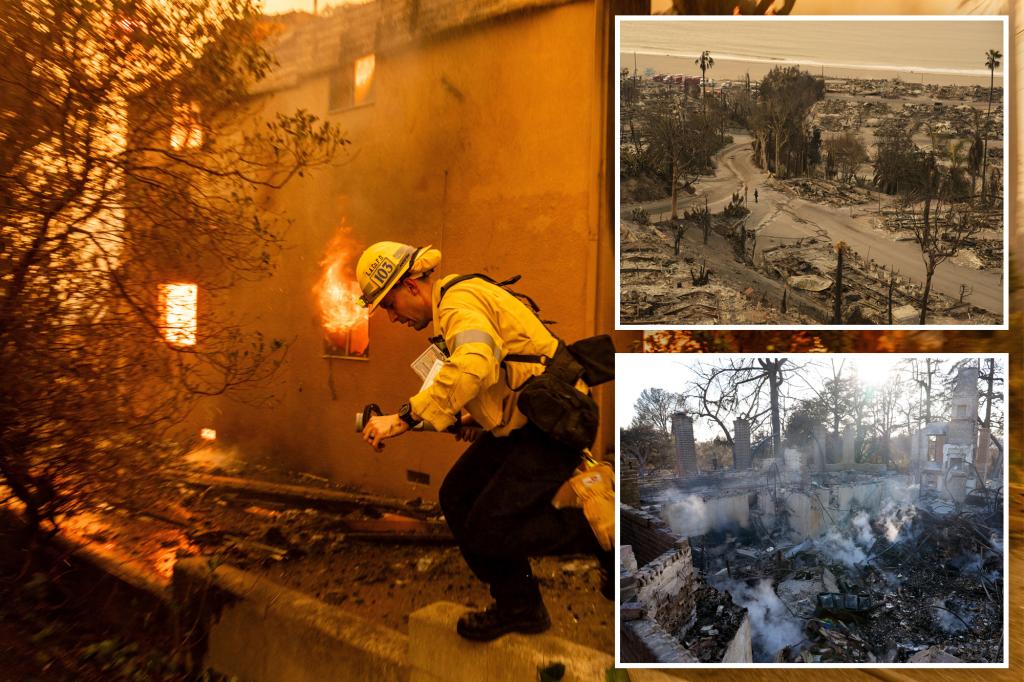The much-anticipated weekend rains bring a mixed blessing to the fire-ravaged landscape of Los Angeles. While offering the potential to quell the persistent Palisades and Eaton fires, they also carry the ominous threat of deadly mudslides and floods. Since October, Los Angeles has experienced a mere 0.6 inches of rain, making the parched land exceptionally vulnerable to the incoming deluge. While the general area is expected to receive up to half an inch of rain, the mountainous regions north of the city, where the fires continue to smolder, may see over an inch. This substantial rainfall, while desperately needed, presents a double-edged sword, as the arid conditions increase the risk of catastrophic mudslides and flooding in the burn scar areas.
The interaction between heavy rainfall and the scorched earth creates a perilous scenario. The absence of vegetation in the burn zones leaves the soil exposed and unable to absorb the incoming water. Consequently, the rainwater rapidly transforms into destructive torrents, carrying loose debris, mud, and even boulders down the slopes. These mudslides can bury homes, damage infrastructure, and pose a significant threat to life. The 2018 Montecito mudslides, triggered by heavy rains on wildfire-scarred mountains, serve as a stark reminder of the devastation these events can unleash, having claimed 23 lives. Beyond the immediate danger of mudslides, the accumulated oil, dust, and ash on roadways pose an additional hazard, turning them into treacherous surfaces with the potential to cause accidents.
The environmental impact of the impending rainfall further complicates the situation. The runoff from the burn scars carries a toxic cocktail of chemicals and debris, posing a risk to both the soil and water supplies. Burned structures, vehicles, and household items release harmful substances into the environment, potentially contaminating groundwater and impacting human health. The uncertainty about the specific chemicals present in the runoff adds to the concern, as a variety of hazardous materials may have been stored or used in the affected areas. This contamination presents a long-term challenge, requiring extensive cleanup and mitigation efforts to restore the ecological balance.
Recognizing the looming dangers, state agencies have proactively deployed specialized teams to vulnerable communities near the burn scars. Governor Newsom issued an executive order expediting debris removal, strengthening flood defenses, and stabilizing hillsides in affected areas. These preemptive measures aim to mitigate the risks and protect communities from the potential onslaught of mudslides and floods. The swift response underscores the seriousness of the situation and the commitment to safeguarding lives and property in the face of the impending rainfall.
While the rain offers a glimmer of hope for extinguishing the wildfires, their complete suppression remains uncertain. The Palisades Fire, which has consumed over 24,000 acres since its ignition on January 7th, was 63% contained as of Wednesday morning. The Eaton Fire, covering approximately 14,000 acres in northern LA County, reached 91% containment. However, containment does not signify complete extinction. These fires will persist until they exhaust their fuel sources, a process that could take weeks in the densely forested terrain north of Los Angeles. Firefighters face the challenge of waiting for the remaining fuel to burn out, a painstaking process that requires constant monitoring and vigilance.
Even when the flames subside, the fire’s threat lingers. Underground roots and other smoldering materials can reignite, posing a hidden danger. Firefighters must meticulously inspect the soil for these smoldering embers, ensuring that the fire is truly extinguished and preventing potential flare-ups. This post-fire monitoring is crucial to prevent re-ignition and ensure the safety of the surrounding areas. Despite the ongoing fire suppression efforts, the immediate threat to structures has subsided. The fires have already inflicted significant damage, ripping through some of Los Angeles’ most expensive neighborhoods and causing an estimated $250 billion in short- and long-term damages. The focus now shifts towards mitigating the potential impact of the upcoming rains and embarking on the long road to recovery.

